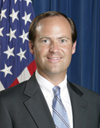
- Afghanistan
- Africa
- Budget Management
- Defense
- Economy
- Education
- Energy
- Environment
- Global Diplomacy
- Health Care
- Homeland Security
- Immigration
- International Trade
- Iraq
- Judicial Nominations
- Middle East
- National Security
- Veterans
- President's Cabinet
- USA Freedom Corps
- Faith-Based & Community Initiatives
- Office of Management and Budget
- National Security Council
- USA.gov
|
Welcome to "Ask the White House" -- an online interactive forum where you can submit questions to Administration officials and friends of the White House. Visit the "Ask the White House" archives to read other discussions with White House officials.
|
|
|
February 25, 2008
Jay Hein
Good afternoon. This morning, I had the pleasure of presenting President Bush with a new report entitled The Quiet Revolution. This report offers the first-ever comprehensive analysis of the successful implementation of the President’s vision for his Faith-Based and Community Initiative. Although often working behind the scenes, it has reshaped the way government tackles human need and made grassroots charities central in a “determined attack on need” — from at-risk youth, addiction and prisoner reentry to malaria and AIDS abroad. The President highlighted some of the accomplishments detailed in this report to our nation’s governors during their annual National Governors Association meeting at the White House today, underscoring ways the Faith-Based and Community Initiative is taking root in communities across every state. Cliff, from Brimfield, Ohio
writes: Jay Hein Cody, from Boiling Springs
writes: Jay Hein
Thanks for the question. The President has often said that he welcomes good people of faith as well as good people of no faith at all to be government's partner in solving problems. It really takes all of us to provide service at the community level and therefore the Faith-Based and Community Initiative isn’t so much about religion as it is about addressing human need in the most effective way possible. The President’s vision for this Initiative makes both faith-based and community organizations central to his governing strategy because these groups stand among those at the front lines of addressing disease, poverty and other great ills. The President views these groups as invaluable allies and we have found that government can more effectively address needs when it joins with every willing partner, whether faith-based or secular, large or small.
Kim, from Kentucky writes: Jay Hein Matthew, from Chicago, IL writes: Jay Hein Jennifer, from Phoenix, AZ writes: Jay Hein
You’re right – America’s “armies of compassion” are among the first responders addressing some of our toughest community challenges. Yet, the work of faith-based and community organizations is often done with little fanfare. And, the truth is, the FBCI has been carried forward in much the same way. That’s why today’s report is called Quiet Revolution – this profound transformation of government and the partnerships formed with community nonprofits have largely happened behind the scenes. President Bush has done more than any other President to bring these stories into the national discussion and that is why his Quiet Revolution report is so important. It tells the comprehensive story of the profound impact of the Initiative on millions of lives both at home and around the world. And my hope is that this report will help spread the remarkable story of the Initiative’s 7-year record: government transformed, nonprofits strengthened, and lives changed. John, from Texas writes: Jay Hein
The President has often said that the Faith-Based and Community Initiative is not about good intentions but rather results. Therefore, the Office of Management and Budget (OMB) works closely with our office to set measurable standards for the Initiative, which is evaluated under the President’s Management Agenda. This evaluation includes rigorous quarterly planning, reporting and accountability from every agency across the Federal government implementing programs under the Initiative. The Quiet Revolution report gives detail on these measurement activities and reviews national outcomes for key FBCI programs. Please see my response to Kim from Kentucky for additional insight on how we measure state-level activity. Domenic, from Pittsburgh writes: Domenic Jay Hein The goal of the Initiative is to ensure a level playing for every organization willing to partner with government to help the needy—of any faith, or of no faith at all. As the Executive Order that established the Initiative stated, we must build on “the bedrock principles of pluralism, nondiscrimination, evenhandedness, and neutrality.” Government shouldn’t be in the business of trying to figure out what beliefs motivate a charity to serve its neighbors. Rather, it should focus on whether the organization can effectively address human need in partnership with government, and in a way that respects Constitutional parameters.
Jay Hein |




